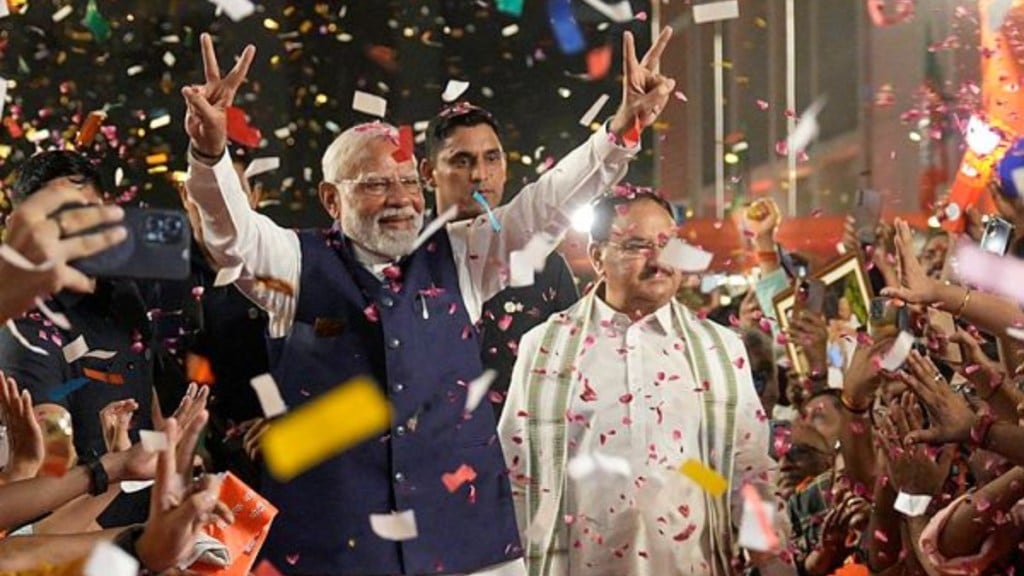–By Rahul Pandey
The 2024 election will be remembered for its timing, drama, and outcomes. The National Democratic Alliance (NDA) won the majority, but the Indian National Developmental Inclusive Alliance (INDIA) provided strong opposition to the BJP. Despite the BJP-led NDA securing the crucial 272 seats, the opposition alliance gained around 230 seats. Congress celebrated its performance even without reaching triple-digit seats. Surprisingly, the BJP leadership appeared subdued despite winning twice as many seats as its nearest competitor and becoming the single-largest party for the third consecutive time since 2014 and 2019.
Political scientist Pratap Bhanu Mehta observed that the verdict showed Prime Minister Modi is no longer an unstoppable force, but just another politician cut down to size by the electorate. Data support this: the BJP lost half its seats in Uttar Pradesh, Modi’s traditional stronghold, and his winning margin shrank significantly from over 400,000 votes in 2019 to just 150,000 votes in 2024. Even Modi’s vote share was lower than in 2014. Despite inaugurating the Ram Mandir in January, the BJP lost the Faizabad Lok Sabha seat, where Ayodhya is located. Analysing the numbers further, the total votes for both the BJP and the Congress increased, with Congress’s vote share rising and the BJP’s slightly declining. The Election Commission reported that about 650 million voters participated, with the BJP receiving over 235.4 million votes, up by more than 10 million from the previous election, and Congress gaining over 15 million votes, totalling 136.6 million. Congress doubled its seats in the lower house despite the BJP not reaching the 272-seat mark. In 2014, the BJP won 282 seats with 31% of the vote, but in 2024, with a 36.6% vote share, they secured only 240 seats. Congress’s tally increased to 99 seats from just 44 and 53 in previous elections, even with a marginal vote share increase. The BJP achieved the highest vote share in most eastern states and significantly increased its share in Kerala and Tamil Nadu, dispelling that it is only a part of North and Western India. It performed strongly in Bihar, West Bengal, Odisha, Andhra Pradesh, and Telangana.
Conversely, Congress increased its tally in scattered areas but failed to make significant inroads in any state. The BJP dominated with over 50% vote share in Himachal Pradesh, Uttarakhand, Delhi, Madhya Pradesh, Chhattisgarh, and Odisha but faced setbacks in Uttar Pradesh, West Bengal, and Maharashtra. In urban areas, the NDA’s vote share increased from 48% in 2019 to 52.08% in 2024. However, the vote share declined in semi-urban, semi-rural, and rural areas. In Uttar Pradesh, the BJP’s vote share fell from 49% in 2019 to 41.37%. The Samajwadi Party gained 33.59%, mainly in the Purvanchal region. In the Hindi heartland, the NDA’s seat count dropped from 196 in 2019 to 130, with a vote share decline from 52.9% to 48.3%. Meanwhile, the INDIA bloc increased its seats from 13 in 2019 to 72, with a vote share rise from 29.7% to 40.1%.
In the five southern states, the NDA won over 50 seats with over 35% of the vote share, compared to 33 seats and 29.8% in 2019. Meanwhile, the INDIA bloc secured 70 seats with a 37.7% vote share, slightly down from 65 seats and a 37.9% vote share in 2019. In the eastern states, the NDA won about 28 seats with a 38.9% vote share, up from 26 seats and a 39.6% vote share in 2019. The INDIA bloc won 2 seats with a 7.9% vote share, excluding the Trinamool Congress and BJD in Odisha.
Will this coalition mandate impact state policies? Not significantly. The coalition partners, except Bihar’s Chief Minister, have limited ambitions beyond their local regions. Parties like TDP in Andhra Pradesh, Shiv Sena (Shinde group) in Maharashtra, and LJP in Bihar primarily focus on their respective areas. Hard policies include re-unifying the Pak-occupied Kashmir (Pok), Uniform Civil Code (UCC), and Delimitation can be backstage since the mandate is fractured, and it’s hard to manage the complex nature of the coalition mantra. The BJP, unaccustomed to coalition mandates, will need to navigate the complexities of coalition politics to make significant decisions. Given the fractured mandate, more social policies are likely to be implemented.
In conclusion, The 2024 election has ushered in India’s complex and multifaceted political landscape. The BJP-led NDA secured the majority but faced significant resistance from the Indian alliance, highlighting the growing strength of the opposition. Despite not achieving a three-digit seat count, Congress celebrated notable gains, indicating a resurgence in its support. The BJP’s performance, while dominant in many regions, showed vulnerabilities, particularly in traditional strongholds like Uttar Pradesh. The party’s leadership now faces the challenge of interpreting these results and strategising for future elections.
The 2024 election has reshaped India’s political landscape, highlighting major parties’ strengths and vulnerabilities. The BJP-led NDA, while securing a majority, faces significant challenges from a strengthened opposition. The rise in Congress’s support and the INDIA bloc’s resilience indicates a more competitive environment. The election results suggest shifting voter dynamics, with regional parties and coalition politics playing crucial roles. As India moves forward, the ability of parties to navigate these complexities will be vital in shaping future policies and governance.
The author is PhD Candidate, China Scholar at the Centre for East Asian Studies (China Division), School of International Studies
Jawaharlal Nehru University, New Delhi.
Disclaimer: Views expressed are personal and do not reflect the official position or policy of Financial Express Online. Reproducing this content without permission is prohibited.
